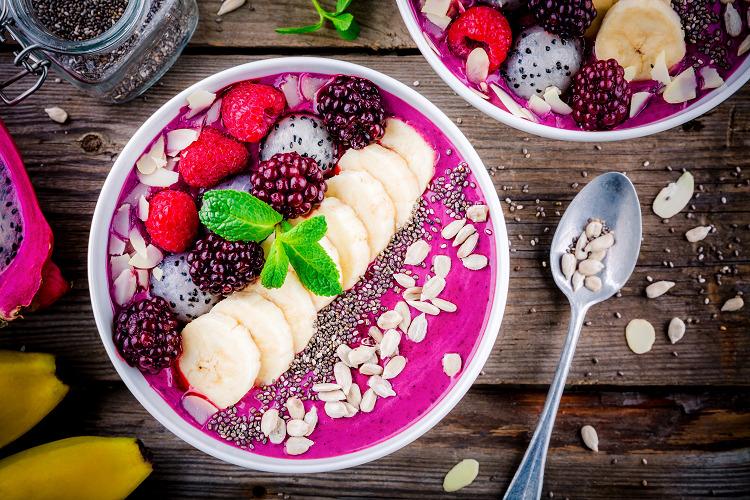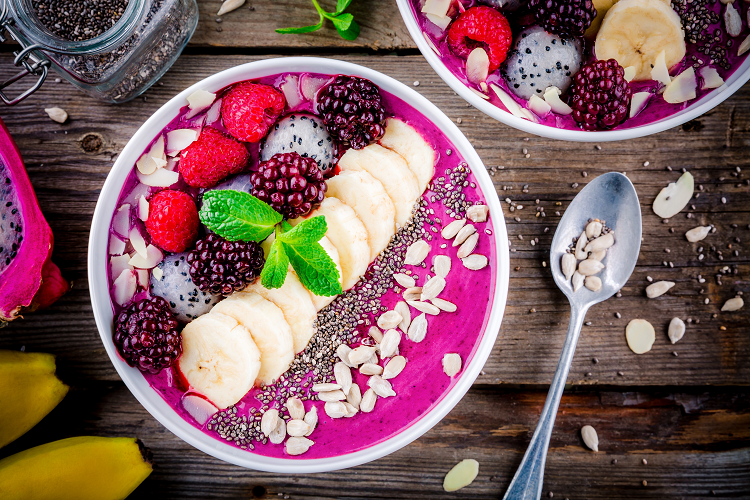The Smoothie Revolution: How A Health Food Curiosity Took Over The Breakfast Table
This is one in a series of stories; visit The Daily Meal Special Report: Breakfast in America: What It Is and What It Means for more.
Smoothies have taken a prominent seat at the breakfast table (if even such a thing exists anymore). Remarkably fast and easy to assemble (throw ingredients into a blender, push a button, and you're out the door!), they have come to dominate the landscape at breakfast, when for most people time is at a premium. A healthy combination of protein, fat, and carbohydrates is generally accepted as a good way to start your day, and smoothies can be an easy, portable way to "blend" these nutrients together to fit our hectic, modern lifestyle. You don't even need to make them yourself: Smoothie shops across the country are waiting with blender tops off, ready to whip up your breakfast in seconds.
How did the smoothie work its way into our collective breakfast repertoire? There's no way to know when the first smoothie was made. In cultures across the world, for hundreds of years, people have puréed or pulverized fruit with fruit juice or water into beverages. In South America, the drink is called a batido or licuado. In Indian culture, lassi is a traditional yogurt-based drink sometimes made savory (with spices and salt) but also turned into a sweet smoothie-like drink with mint and fruit, often mango.
The earliest American ancestor of the smoothie can be traced back to the 1920s, when a real estate broker with a sensitive stomach hired a young man named Julius Freed to run his orange juice stand. Freed began tinkering with a concoction that would allow his boss to enjoy freshly squeezed orange juice without all the acidity the juice contains. The frothy, cool orange drink he came up with — adding powdered egg whites, milk, and flavorings to the juice — gained its name when people began lining up at the stand, and would say, "Give me an Orange, Julius!" (Today the Orange Julius brand is owned by Berkshire Hathaway and the product is sold through its Dairy Queen stores.)
The smoothie would never have been a success without the electric blender. Stephen Poplawski invented the earliest version of this appliance in 1922, to make soda fountain drinks. Poplawski's design was manufactured by L.H. Hamilton, Chester Beach, and Fred Osius, who had formed the Hamilton Beach Manufacturing Company in 1910. Later, in the 1930s, Osius joined with popular bandleader and radio personality Fred Waring (known as "the man who taught America to sing") to further research and improve the mixing device so that it was capable of puréeing fruit. The result was dubbed Waring's Blendor (the spelling eventually changed to "Blender"). Fred Waring boasted that "this mixer is going to revolutionize American drinks." Which it absolutely did.
Also essential to the smoothie's evolution was the rise of refrigeration in the early twentieth century. Freon was introduced in the 1920s, which helped expand the home-use refrigerator market. Separate-compartment freezers were introduced in the 1940s, and frozen food, which was previously considered a luxury, became commonplace over time. Today, frozen fruit sales have reached over $1 billion annually. According to The Wall Street Journal, "Dole Packaged Foods, the largest seller of frozen fruit in the U.S., estimates that in 2014 about 60 percent of frozen fruit purchased went into smoothies, up from about 21 percent in 2006."
What really helped increase the smoothie's popularity over the years, however, was the growth of the health food movement of the 1960s, characterized by the rise of vegetarianism; a desire to return to simple, healthy foods like fruits and vegetables; and a general rejection of processed foods and white-flour ingredients.
In 1970, a lactose-intolerant teenager named Steven Kuhnau, dealing with chronic food allergies, yearned to indulge in the milkshakes enjoyed by his peers. He began blending fruit, fruit juice, and ice, and creating his own healthy mixtures. His concoctions gained popularity among his friends, and in 1973 he opened the first Smoothie King store. The idea caught on, and today there are over 800 Smoothie King franchises worldwide. Smoothie King is just a slice of the booming smoothie and juice industry, which includes big names like Jamba Juice, Planet Smoothie, and Tropical Smoothie Café, as well as innumerable smaller businesses. Even McDonald's and Dunkin' Donuts have gotten in on the smoothie action. What was a niche market as late as the 1990s now accounts for sales of about $5 billion a year, according to FastCasual.com. That's a lot of smoothies.
Smoothies haven't just stayed in the glass, either. They've been given a makeover in the last few years, as the smoothie bowl trend has taken the health food world by storm. People ditched their straws, and glorious bowls combining ingredients like açaí, dragon fruit, granola, and coconut flakes began to dominate Instagram feeds. Some people claim it's just a change in receptacle, but others say the smoothie bowl is healthier than the traditional blended smoothie, because you actually have to chew, so it's more filling, and nutrients and fiber are preserved. Other people warn that since extra ingredients are likely to be added to smoothie bowls (to make them thicker, or simply prettier) they can easily become calorie-laden sugar bombs.
Smoothies can be a vehicle for transforming and improving your health, but smoothies are only as good as what you put into them (and on them, in the case of smoothie bowls). There are conflicting opinions in the nutrition world about the nutritional content of smoothies — some say that the blending of the drinks destroys critical nutrients, or that a heavy reliance on dairy and fruit in the typical smoothie equals excessive sugar. These are compelling arguments, but smoothies can also be an easy way to increase your fruit and vegetable intake, especially for people who may otherwise struggle to reach the recommended daily servings. Penn State's Center for Childhood Obesity Research is currently sponsoring a Green Smoothie Project, aimed at "increasing children's and adults' intake of dark green vegetables through blended vegetable and fruit drinks."
It's common knowledge that the better we take care of our bodies, the healthier we will be. Smoothies can be an excellent breakfast choice, offering a variety of benefits that will help power you through the day and support your future well-being. They may not have had a place at the breakfast table for as long as oatmeal or eggs, but it looks like they are here to stay.

